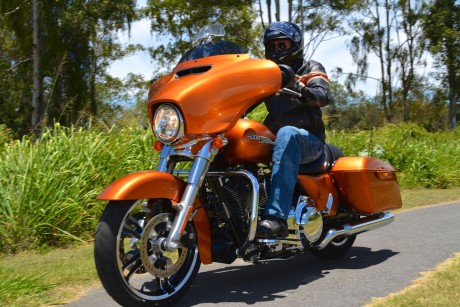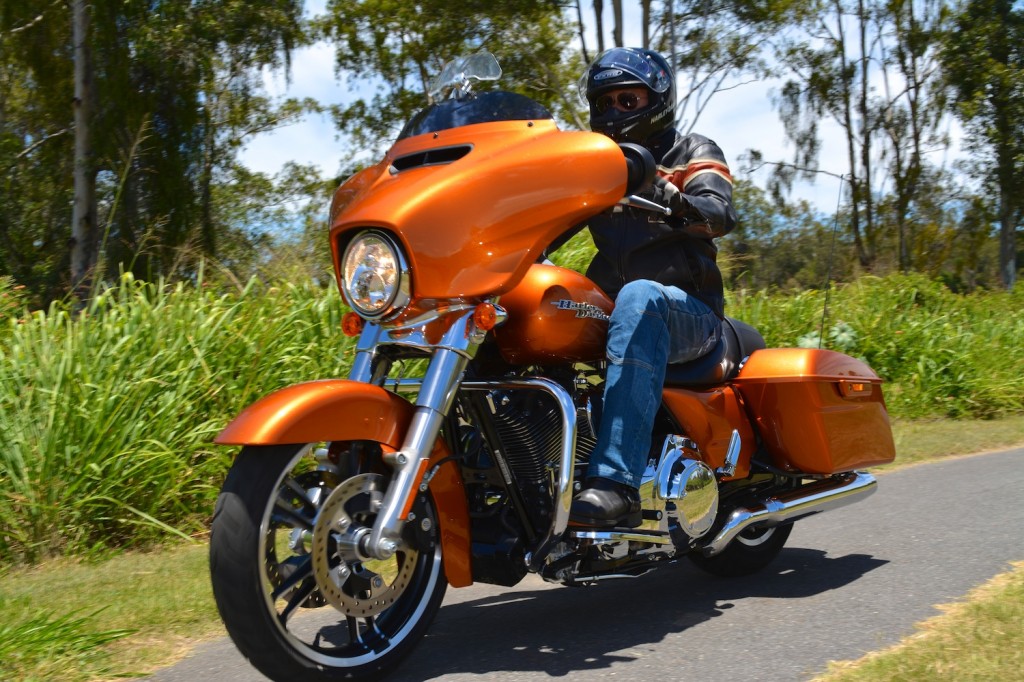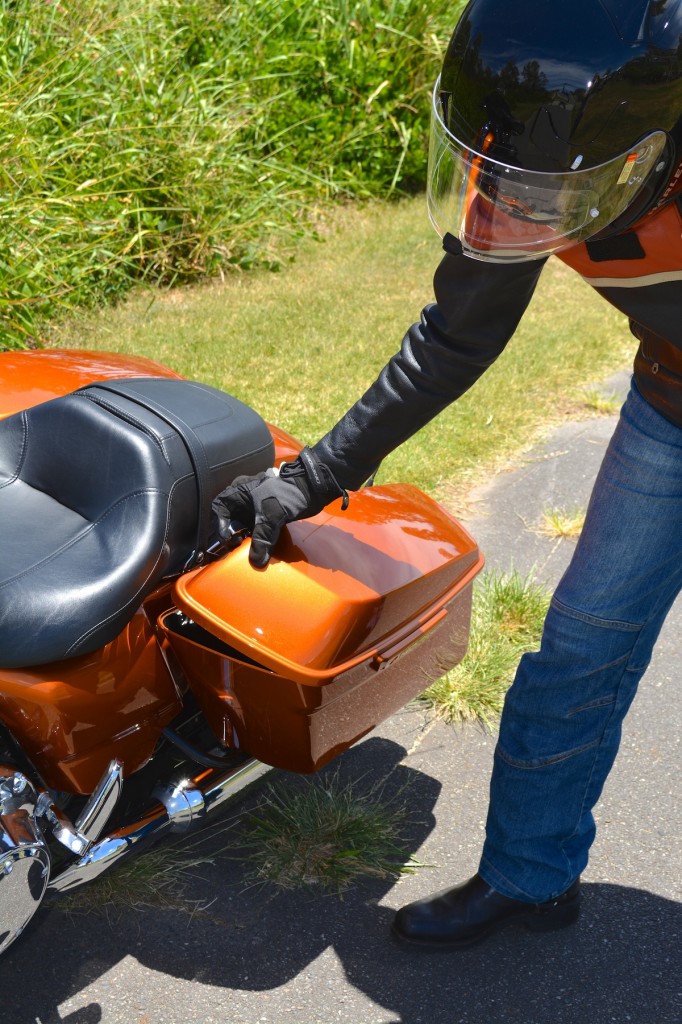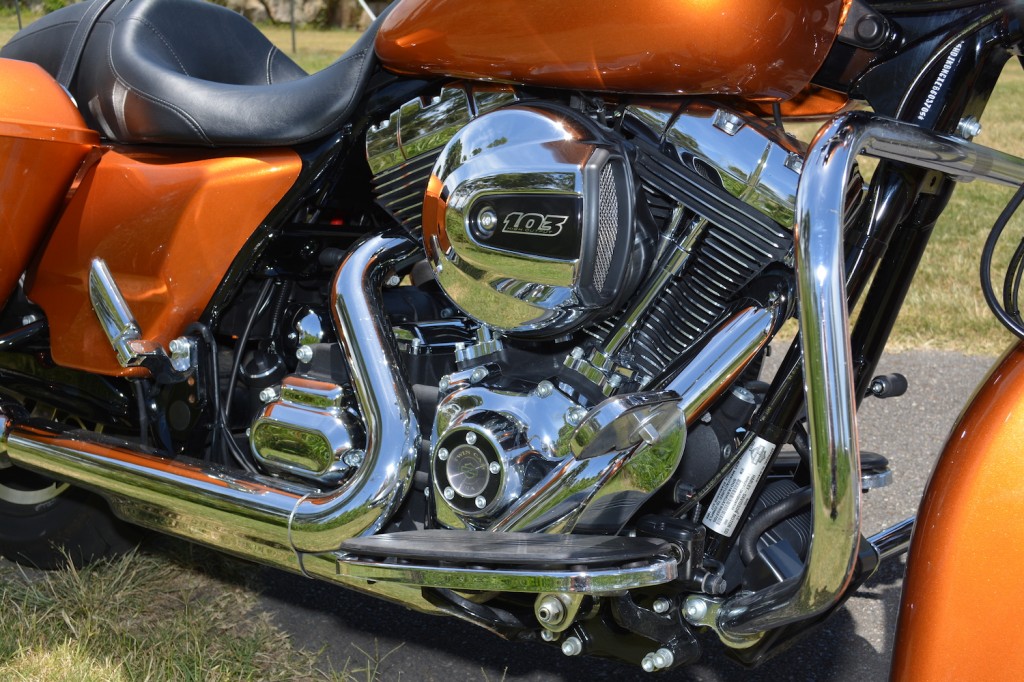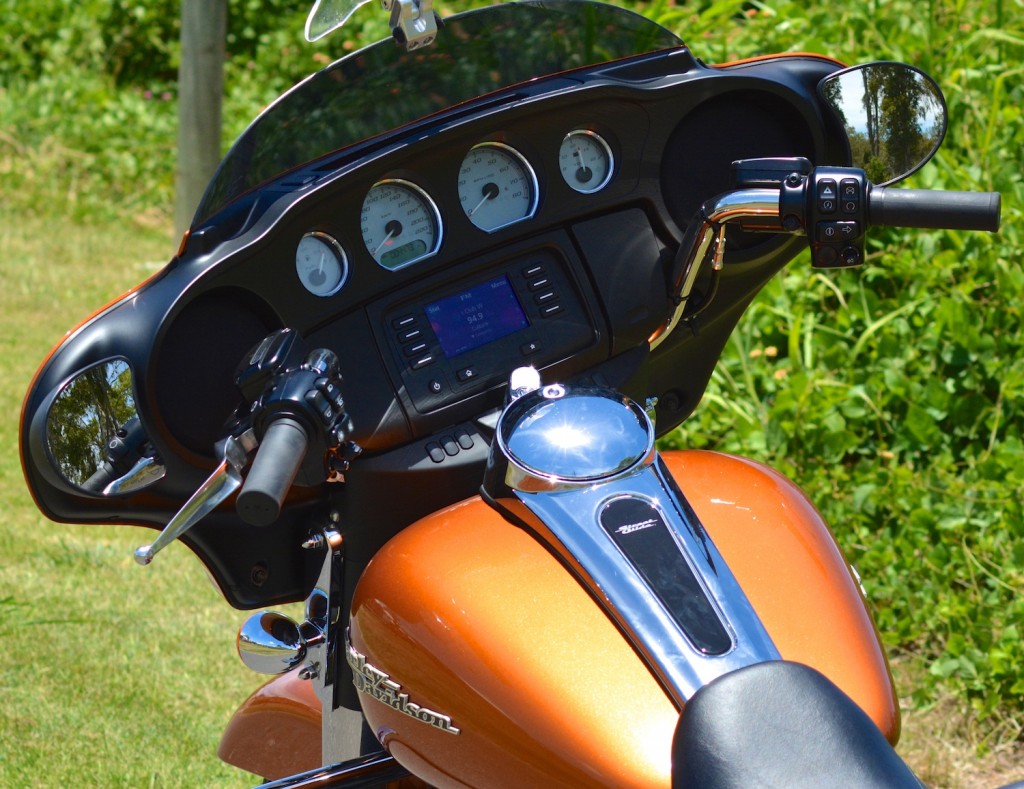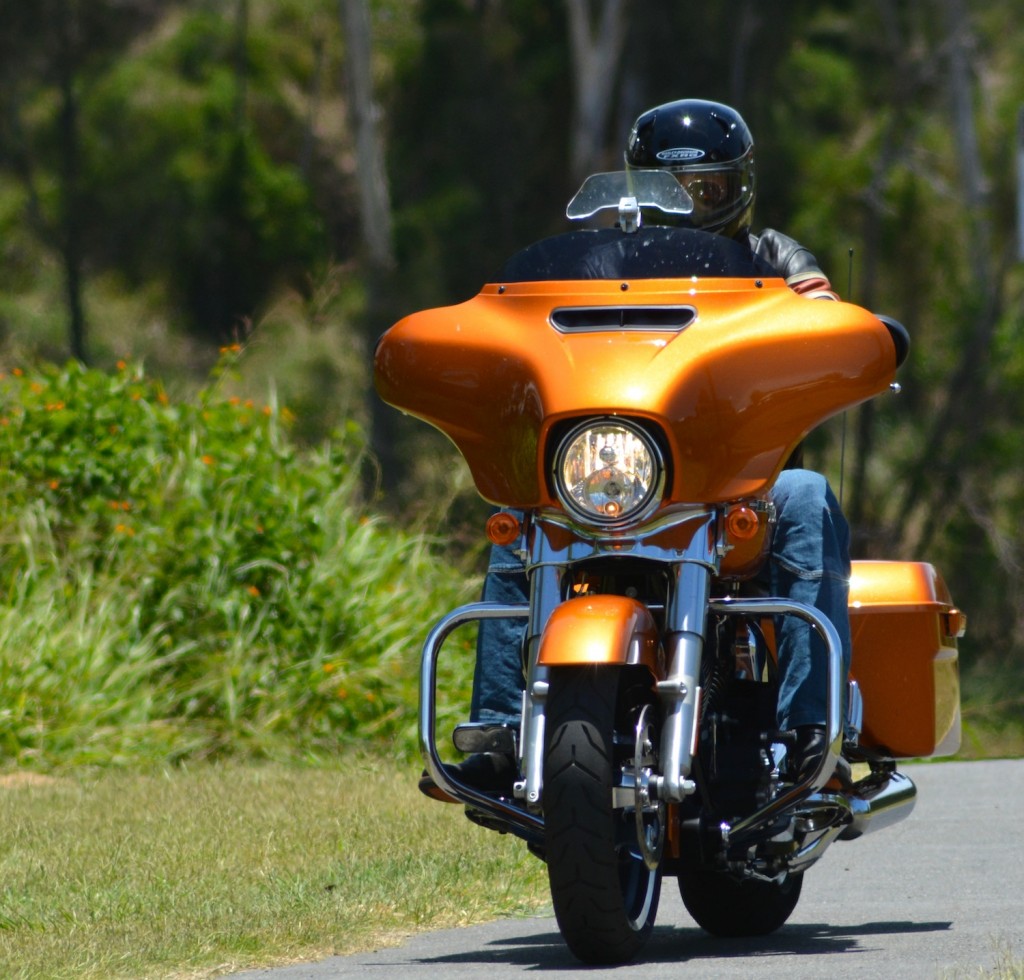Despite the numerous changes to the 2014 Harley-Davidson Street Glide, there are two that stand out the most. Well, actually one of them doesn’t stand out at all. I’m talking about the new slimline air filter.
Most riders replace the bulky air filter as their first order of business when they buy a new Harley.
They are ugly, bulky and awkward because of their size. You tend to ride along with your right knee waving in the breeze.
The new slimline air filter on the Touring range looks smart and its low profile means you can squeeze your knees right up to the tank.
The other feature that stands out on the Street Glide is the new pannier handle.
Instead of opening the panniers from the outside, there is a neat little chromed handle on the inside next to the rider which can easily be opened while still seated.
The pannier lid opens the opposite way and it is now a one-handed operation instead of the previous complex and awkward two-handed operation.
Simple low-tech solutions such as these are the result of Harley going back to its riders and asking what they wanted.
They called it the Rushmore Project and it was used to develop the 2014 range of Touring bikes. But there are far more hi-tech updates than a handle and narrow filter.
They include comprehensive infotainment systems, some with GPS; wind-tunnel aerodynamics; LED and halogen headlights; linked brakes with ABS; hydraulic clutch; and partial water cooling.
The latter is a response to government regulations on emissions and economy rather than consumer requests and it’s only available on the Ultra which has fairing lowers.
It isn’t available on the Street Glide which retains its iconic “batwing” fairing.
You can quickly tell the difference between the old and new Street Glides by the little horizontal split in the fairing just under the windscreen. It’s an air vent that you can open and close and is the result of extensive aerodynamic testing in a wind tunnel at two American universities.
What happens with most fairings and windscreens is that they push air, creating negative pressure behind the screen, so the air rushes in to equalise the pressure, causing buffeting. This is not only noisy, but fatiguing on a long ride.
For some years, the Honda Gold Wing has had a similar air vent in its wind screen, so it seems strange Harley took this long to follow the lead. Maybe they wanted to retain that unbroken batwing fairing look. But I don’t think it upsets the shape. In fact, it adds to its streamlining and reduces its brutal visual impact.
I rode a Street Glide with a big touring windscreen at the world launch in Denver, Colorado, and was amazed at how effective it was.
At 180km/h I could still hear the powerful Boom! Box audio system and did not get any significant wind buffeting. There is a little button on the dash that opens and closes the vent so you can feel the vast difference it makes.
I hate windscreens and can see no point in audio systems on a bike, but this little vent made all the difference. Suddenly I could appreciate my music at speed and ride all day, protected by the elements, without getting fatigued by buffeting. So when I scored a Street Glide in Australia for a month-long test, I was excited.
However, the Street Glide test bike came with a shorty cutdown windscreen so the vent makes absolutely no difference. The screen is simply too low. At anything over 60km/h my sunnies started to wobble.
Over 80km/h my helmet started to cop buffeting and I could no longer hear the audio clearly.
Over 100km/h it was time to turn around and go home where I fitted a small Wunderlich windscreen extension which I’ve used on many windscreens to clean up the airflow. It sits slightly above the windscreen, creating another little vent to reduce negative air pressure.
With the extension fitted, I can ride with all the features of the bigger screen, but still with the slammed look of the lower screen.
The 2014 Street Glide is powered by a new air-cooled High Output Twin Cam with a higher and earlier cam profile and a high-flow air filter that increase output by 5%. It may be a little snappier on the throttle, but the difference is negligible. What is noticeable is that it seems to run a little leaner than before and on my test I achieved bang on the claimed figures of 5.6L/100km.
The Street Glide’s 103 engine is a lusty, torquey beast of a thing that requires little thought about appropriate gears, which makes it easy to ride. Gears are still a bit clunky, neutral can be difficult to find and sixth is only a cruising gear above 100km/h.
The stock exhaust is on the quiet side unless you really rev the engine. It’s so quiet I often found myself on the highway still in fourth gear. So the fuel economy could have been even better than my figures if I’d paid more attention to the gear indicator on the instruments.
The new hydraulic clutch feels light and precise, however it has been the subject of a safety recall.
The notice says that some may “lose the ability to generate enough lift to disengage the clutch”. Replacement work is done for free.
The new “Reflex” linked brake system with ABS has plenty of feel and effect, so long as you give them a fair squeeze. The ABS is smooth and doesn’t get excited quickly in a panic stop. Just keep squeezing hard and the nose dips a little less than before and the big 367kg machine pulls up to a crunching halt. It’s reassuring. The linked brakes don’t operate until 40km/h so you can still control the bike in slow-speed maneuvres such as feet-up u-turns using just the back brake.
The handlebars turn so tight ands the bike is so controllable at slow speeds, I can do feet-up u-turns even in our narrow suburban street where barely two cars can pass each other.
Touring Harleys have been competent handlers since the frame was stiffened a few years ago. It’s been stiffened even more and the results are noticeable.
While the static lean angle hasn’t been improved, the more rigid frame, together with the stiffer and 14% thicker 49mm forks means it wallows even less than before for better dynamic lean angles. The foot pegs will still touch down, but a little less often than before.
The steering geometry has also been sharpened slightly for a quicker turn-in and less front-end push. The Street Glide is now one of the best handling cruiser-tourers on the market, even though it might not have the lean angle of the Victory, Indian or some of the metric cruisers.
Riders will also find the new ergonomics more comfortable with less reach to the bars, a narrower front part of the seat so you can get your feet flat on the ground a little easier and that narrow air filter so your legs aren’t splayed. However, my pillion wasn’t too happy with the rear seat. It’s a bit narrow and thin and it slopes away from the rider in a styling exercise to match the shape of the rear fender. That means the pillion feels as though they are slipping away from the rider with only a sash to hold on to. A sissy bar would be an essential aftermarket option if you carry a pillion.
Riders will find the controls a lot easier than before with contoured switches for better feel without having to look at them and a couple of simple five-way toggles on both bars to navigate your way around the infotainment screen. You can also reach forward and hit the buttons around the screen, but why bother when all functions can be done by the thumb toggles?
The instrument panel is now less fussy, easier to read and navigate. With only three gauges instead of five there is also more room for bigger, more more legible numbering and lettering and more room for bigger speakers. You can also fit more powerful Boom! Box speakers with 1% distortion and a colour touchscreen infotainment centre with GPS. I’ve tried it and the difference from the stock unit fritted to this test bike is substantial. In fact, I would either have a Boom! Box audio or nothing than the stock audio unit set-up.
A few night cruises with the new dual halogen headlights proved their value in providing an even light across darkened streets. I’ve also tried the new Daymaker LED lamps ($661) which figuratively turn night into day. Just make sure they are properly aligned so you don’t dazzle oncoming traffic.
Harley-Davidson FLHX Street Glide tech specs
- Price: $31,082 ($33,995 rideaway)
- Warranty: 2 years/unlimited km
- Service: 1600/8000km
- Engine: Rubber-mounted, air-cooled 1690cc High Output Twin Cam 103
- Power: not given
- Torque: 142Nm @ 3250rpm
- Bore x stroke: 98.4 x 111.1mm
- Compression: 10.1:1
- Transmission: 6-Speed Cruise drive with hydraulic clutch
- Suspension: 49mm forks, dual air adjustable shocks
- Tank: 22.7 litres
- Brakes: 300mm discs, Reflex linked system with ABS
- Wheels: 130mm, 17-inch front; 180mm,16-inch rear
- Dimensions: 2450mm (length), 960mm (width), 1350mm (height), 663mm (seat), 135mm (clearance)
- Wet weight: 367kg
- Economy: 5.6L/100km
- Lean angle: 32° (right), 31° (left)


